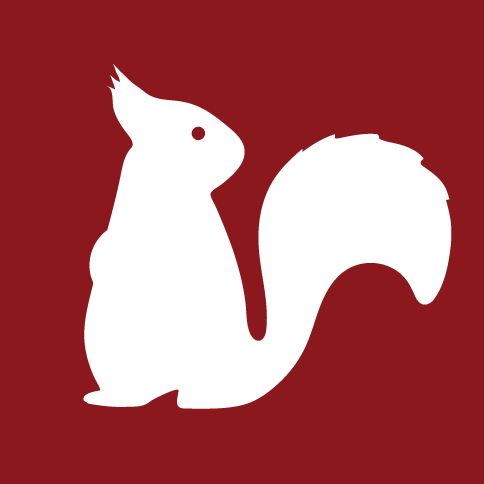Learn more about red squirrels, including where they are found, and how they're threatened by the spread of non-native grey squirrels in our expert guide by the Saving Scotland's Red Squirrels project.
What is a red squirrel?
Red squirrels are a small mammal which falls under a rodent group called Sciuridae (meaning shadow-tailed).
There are more than 200 species of squirrel around the world. Examples of the squirrel family includes tree squirrels, ground squirrels and flying squirrels. Scotland’s native red squirrel is a tree squirrel.
Learn more about rodents in the UK:
How to identify red squirrels
Red squirrels sport iconic ear tufts, typically in the colder months but they can be present throughout most of the year. If their ginger colouration isn’t an easy giveaway, their ears are a great way to distinguish them from their non-native cousin, the grey squirrel, whose ears are more mousy in shape without any tufts.
A red squirrel’s tail is dense, bushy and mainly of one solid colour. Their colouration does vary, however; some are pale brown, grey or almost black and their tails often go quite blonde in summer, starting at the tip. There are also a number of conditions that can affect coat colouration, such as albinism and leucism.
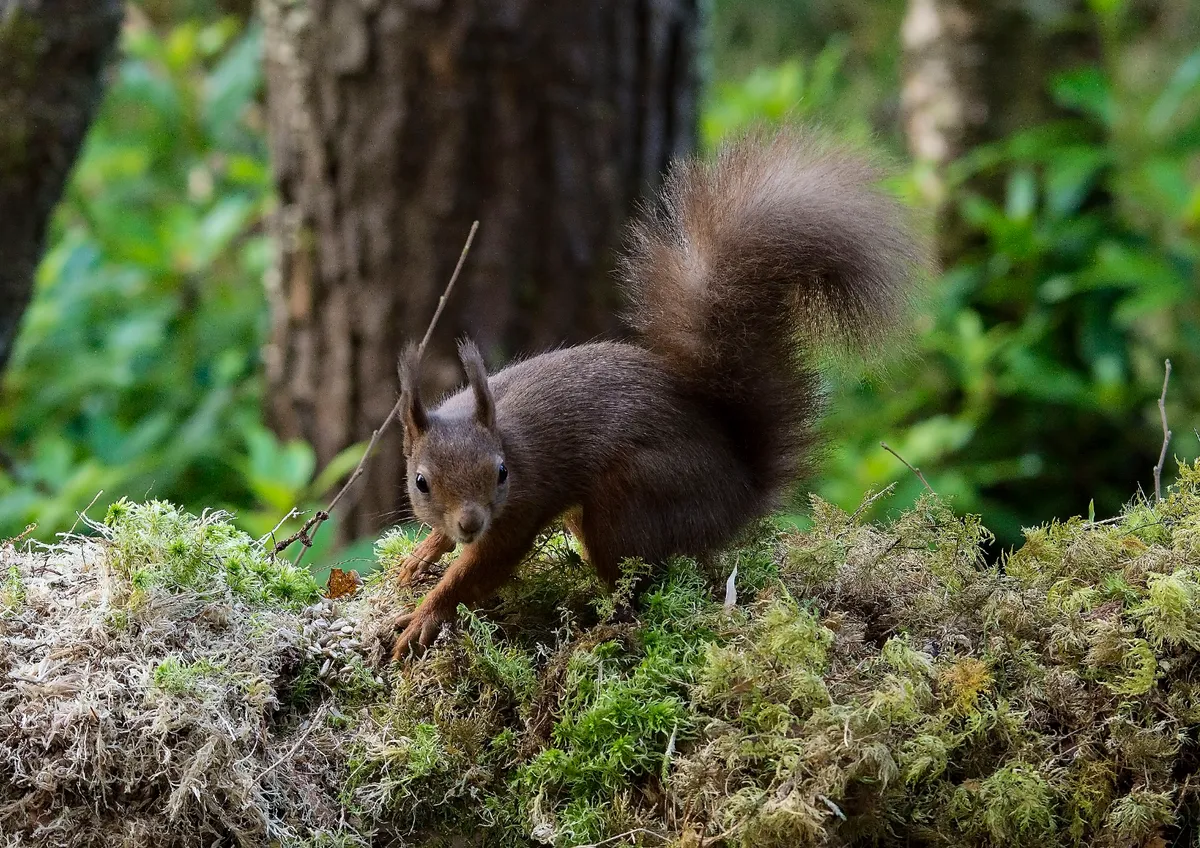
A grey squirrel, weighing roughly twice as much as a red squirrel, is of heavier build and has a distinct bright ‘halo’ effect or silver fringe around its tail. Where this effect can’t be seen and identification between species is uncertain, a hair sample can be analysed under a microscope to confirm if the squirrel is red or grey.
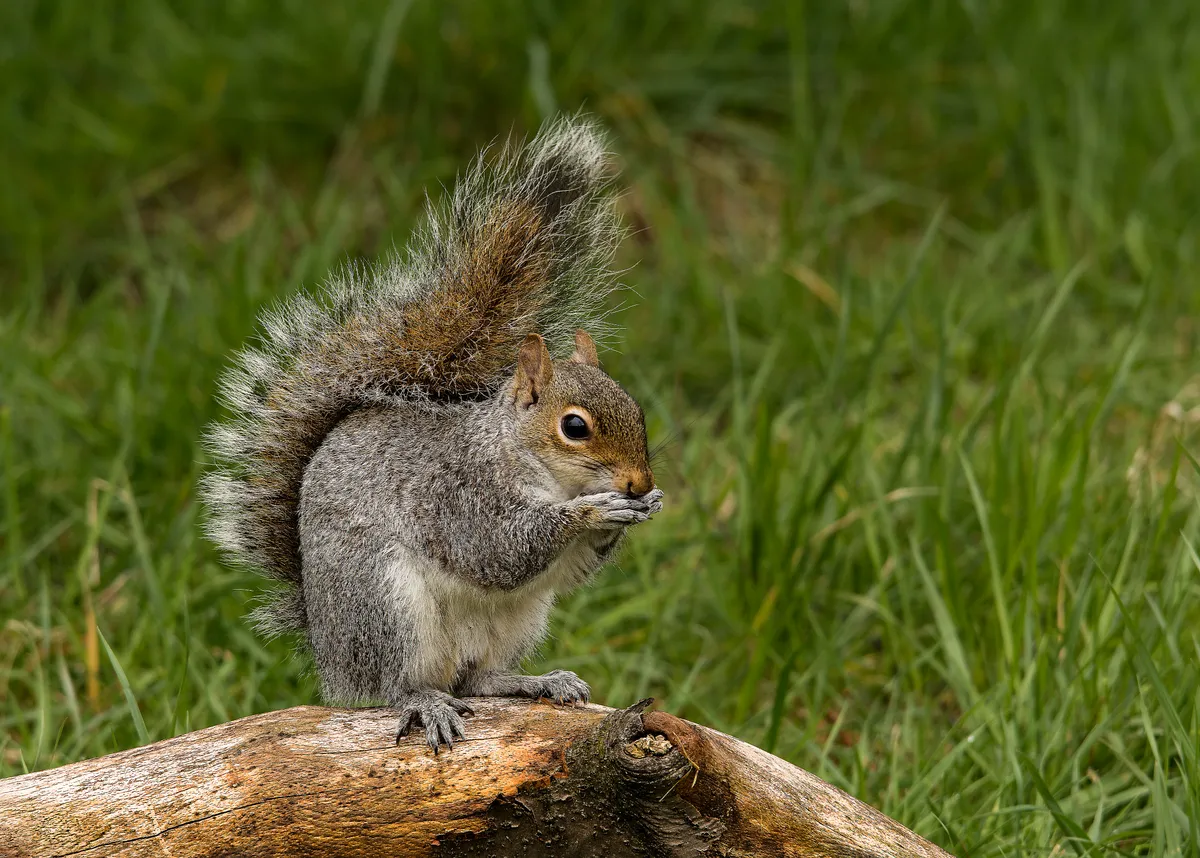
Where are red squirrels found?
Globally, the Eurasian red squirrel has a wide geographical range extending from the United Kingdom, Ireland, Spain and Portugal through forested habitat across most of Europe, Russia and Northern China. The red squirrel is the only squirrel species native to Britain.
Once widespread throughout the UK, red squirrels have suffered a drastic population decline since the introduction of the non-native grey squirrel in the 1800’s.
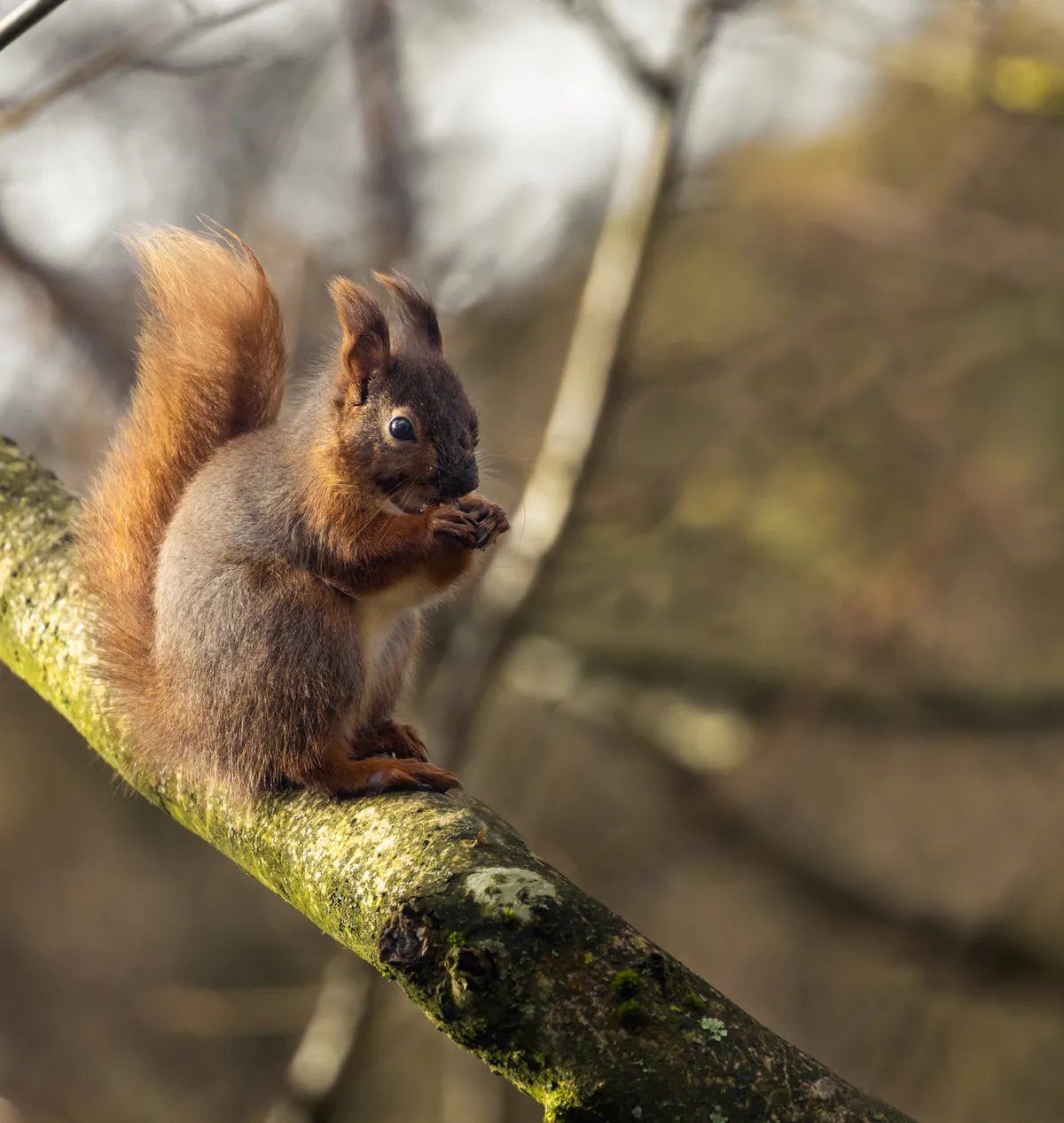
Red squirrel strongholds remain in Scotland, the Lake District and Northumberland with some isolated, remnant populations further south in England and Wales including Anglesey, mid-Wales, Formby in Lancashire, Brownsea Island in Dorset and the Isle of Wight. Scotland is home to 75% of the UK’s remaining population.
In Scotland, an estimated 120,000 red squirrels remain today when there would once have been millions.
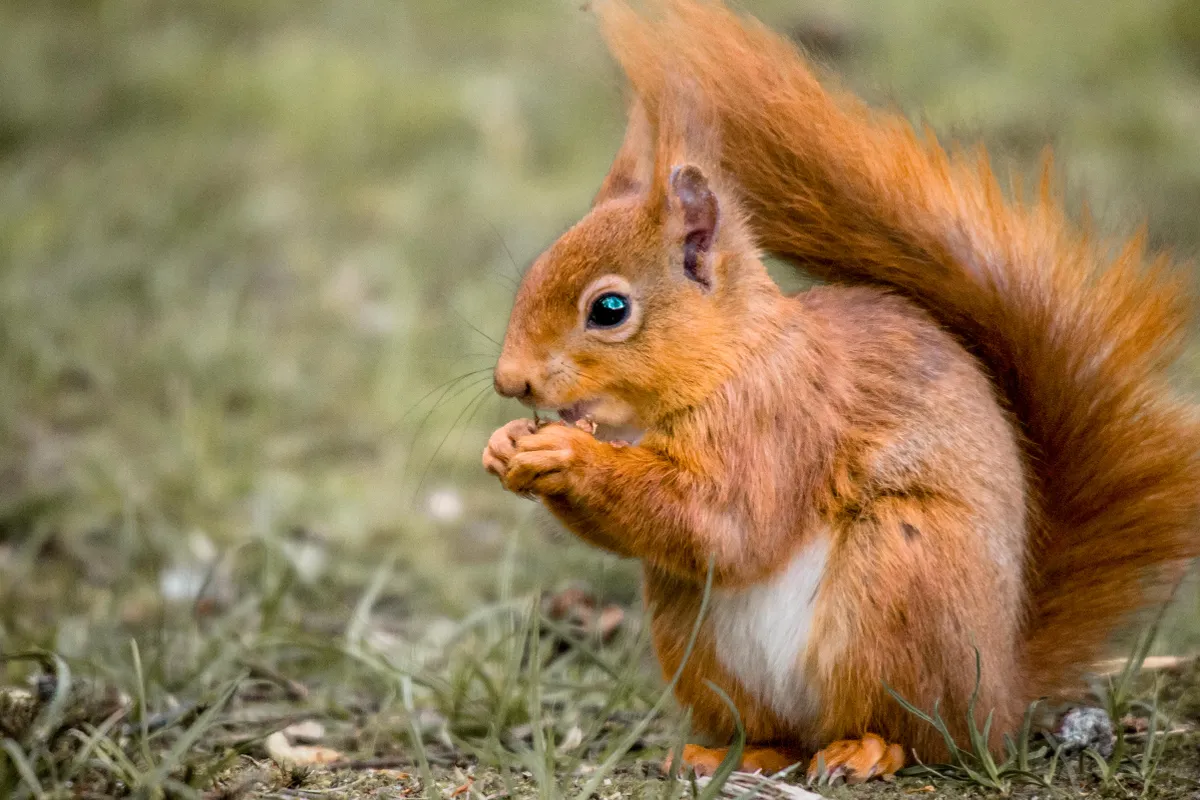
How big are red squirrels?
An adult red squirrel can grow to between 18cm and 24cm in length with tails an average of 18cm in length. On average, they weigh nearly 300g, a little less than a can of soup. There is no difference in size between the sexes.
As a comparison, one of the smallest squirrels in the world is the African pygmy squirrel, weighing just over 15g. One of the largest squirrel species, is the Indian giant squirrel which can weigh over 1.5kg.
What do red squirrels eat?
Red squirrels are specialist tree-seed feeders. Favourites are hazelnuts, yew seed, elm seed and the seeds of pine, spruce and larch cones. It has been estimated that a single squirrel can eat the seeds from up to 20,000 cones in a year. Their constantly growing chisel-sharp incisors ensure that they can deal with tough cone scales and nuts with astonishing efficiency.
They also eat fungi, fresh leaf and flower shoots, flowers and fruits of some shrubs and trees, bark and sap and sometimes birds' eggs and insects. A red squirrel can tell if a nut is good or bad before opening it by its smell.
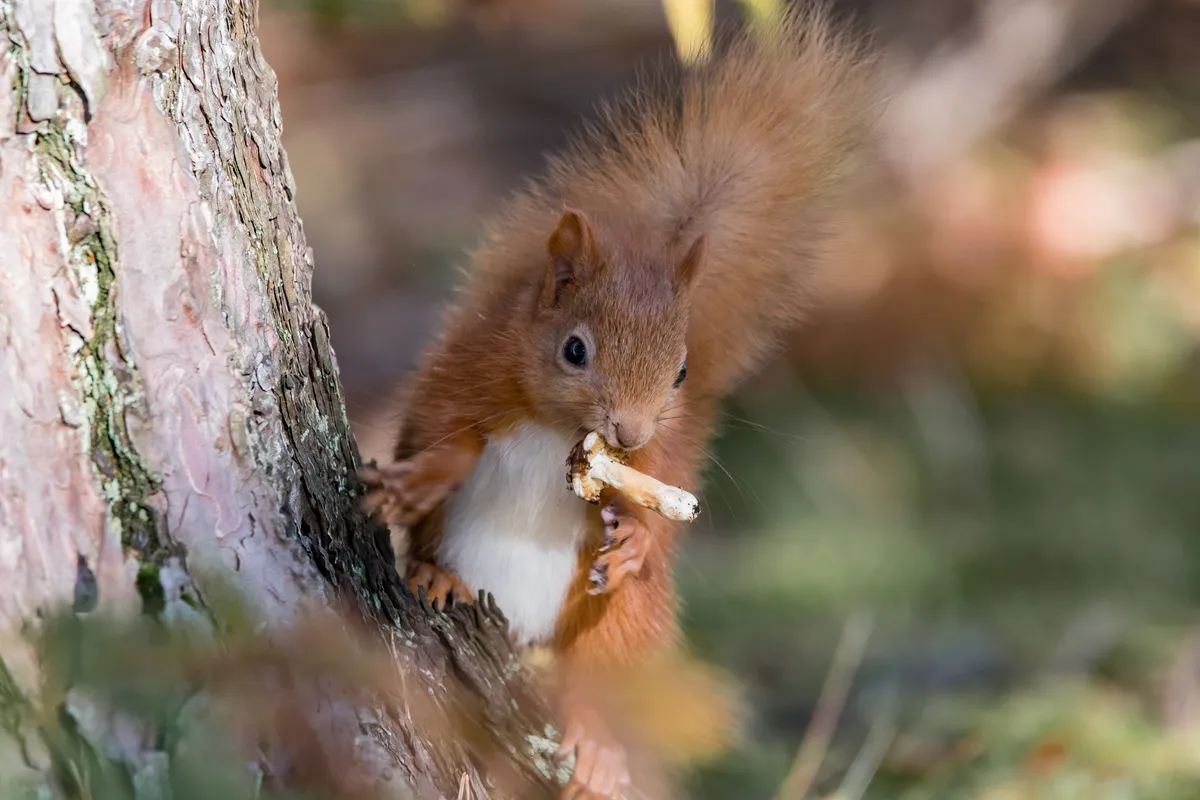
Look out for fungi placed high up in the forks of tree branches in autumn: squirrels leave them out to dry before hiding them away for the winter, along with stores of seeds and nuts. Food items are stored singly (so-called scatter-hoarding) rather than in large caches.
A characteristic sign of feeding squirrels is a littering of stripped cones beneath cone-bearing trees. A messy scatter of cone cores and scales will most likely have been left by a squirrel feeding in the canopy, while a neat heap of stripped cores and scales close to shelter is more likely to have been a mouse or vole feeding on fallen cones.
Another classic squirrel feeding sign is the neatly halved hazelnut shell with a small chiselled nick in the apex, distinguishing them from the gnawed holes in the shells made by mice and voles.
There is no difference between the feeding remains of red and grey squirrels.
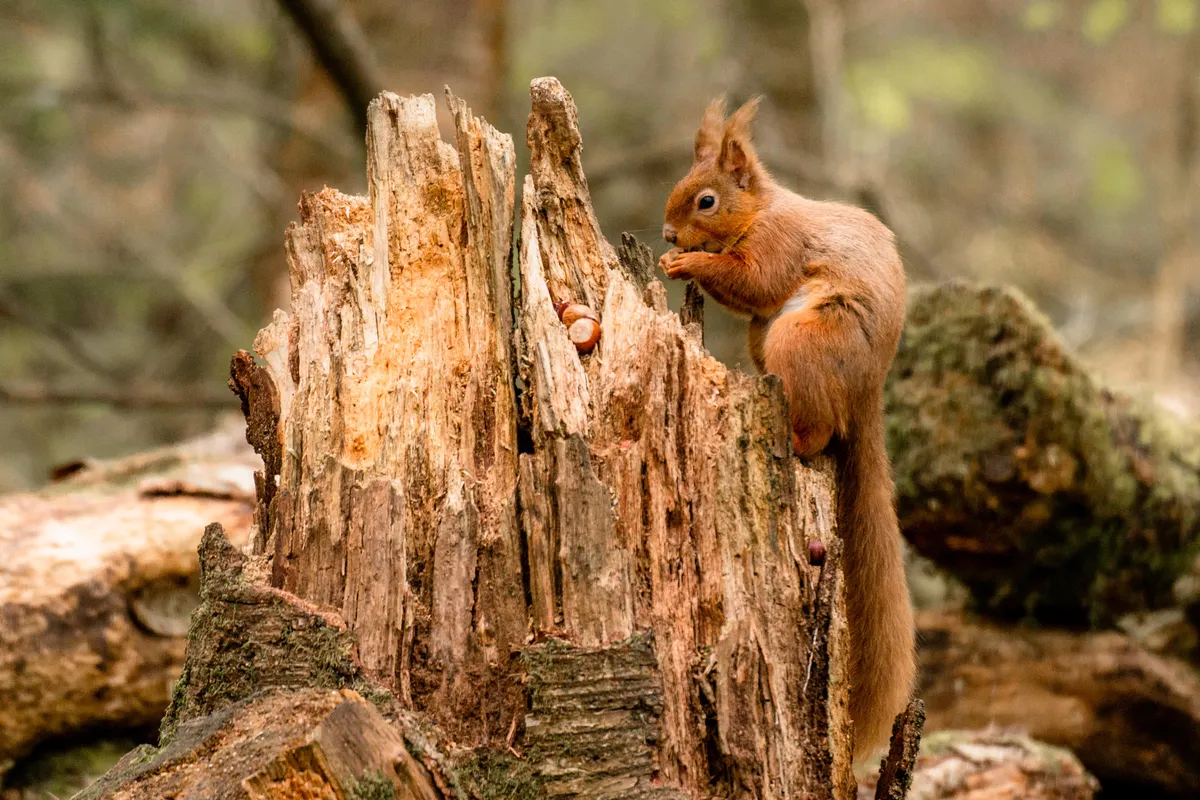
What predators do red squirrels have?
Adult red squirrels face the threat of avian predators, such as goshawks and buzzards, and may fall prey to domestic cats or foxes, as they forage on the forest floor.
Red squirrels are also occasionally preyed upon by pine martens, but red squirrels and pine martens have coexisted naturally in Britain and across Europe for millennia, so red squirrel populations can easily withstand this level of predation.
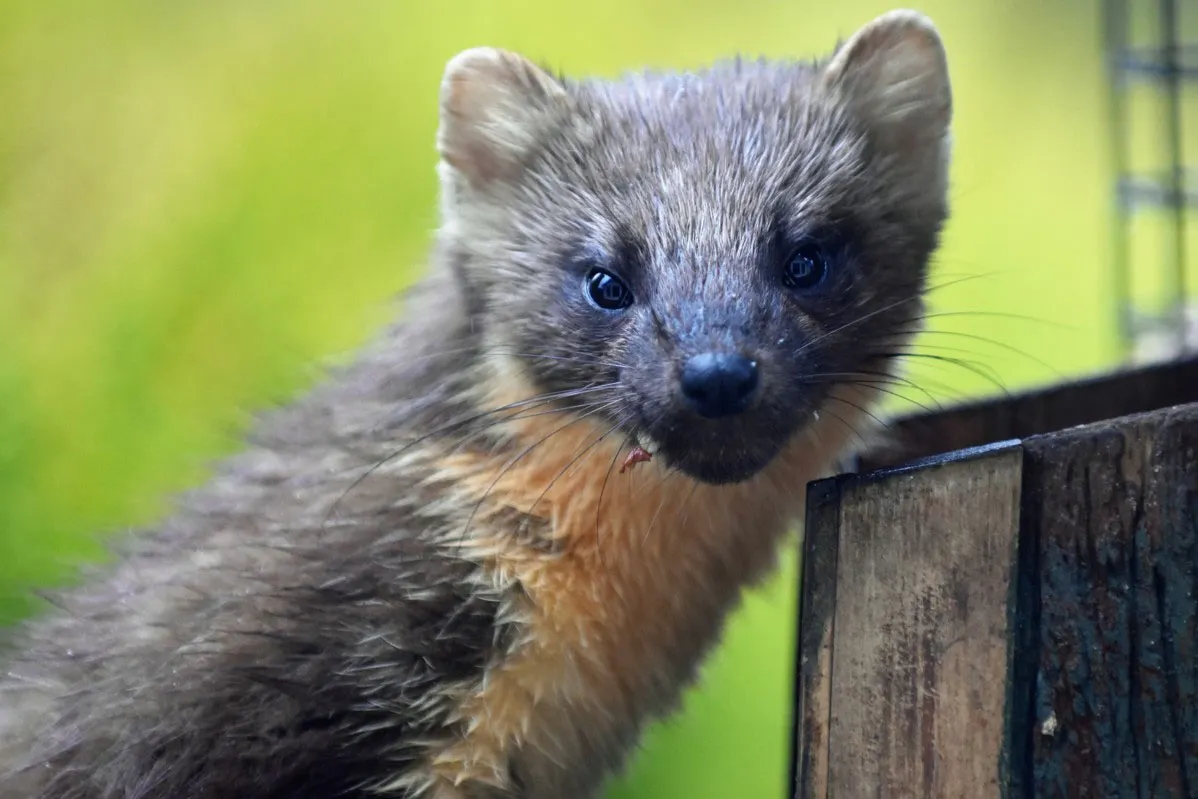
Research has shown that where pine martens occur alongside overlapping populations of red and grey squirrels, there is a trend of decline in grey squirrels and an increase in red squirrels. Pine marten could therefore be a natural ally for the red squirrel where it occurs in Scotland.
Learn more about pine martens and how they benefit red squirrels:
Humans also influence the population size and mortality of the red squirrel by destroying or altering habitats and by causing road casualties. However, the human action that became the disastrous tipping point for native red squirrels was the introduction of non-native North American eastern grey squirrels.
How long do red squirrels live for?
Red squirrels have a lifespan of roughly 3 years in the wild, but can live up to 7 years. It has been known for a red squirrel to live up to 10 years in captivity.
What are baby red squirrels called?
A baby red squirrel is called a kitten, or kit. Red squirrels breed in spring and summer, with pregnancy lasting between five and six weeks. They will have between one to six kits per litter, with typically two to four reaching weaning in the UK.
Kits are born only weighing around ten to 15 grams each, completely blind and deaf. By week three, they will be covered in hair and by week four they will start to open their eyes and have the ability to hear.
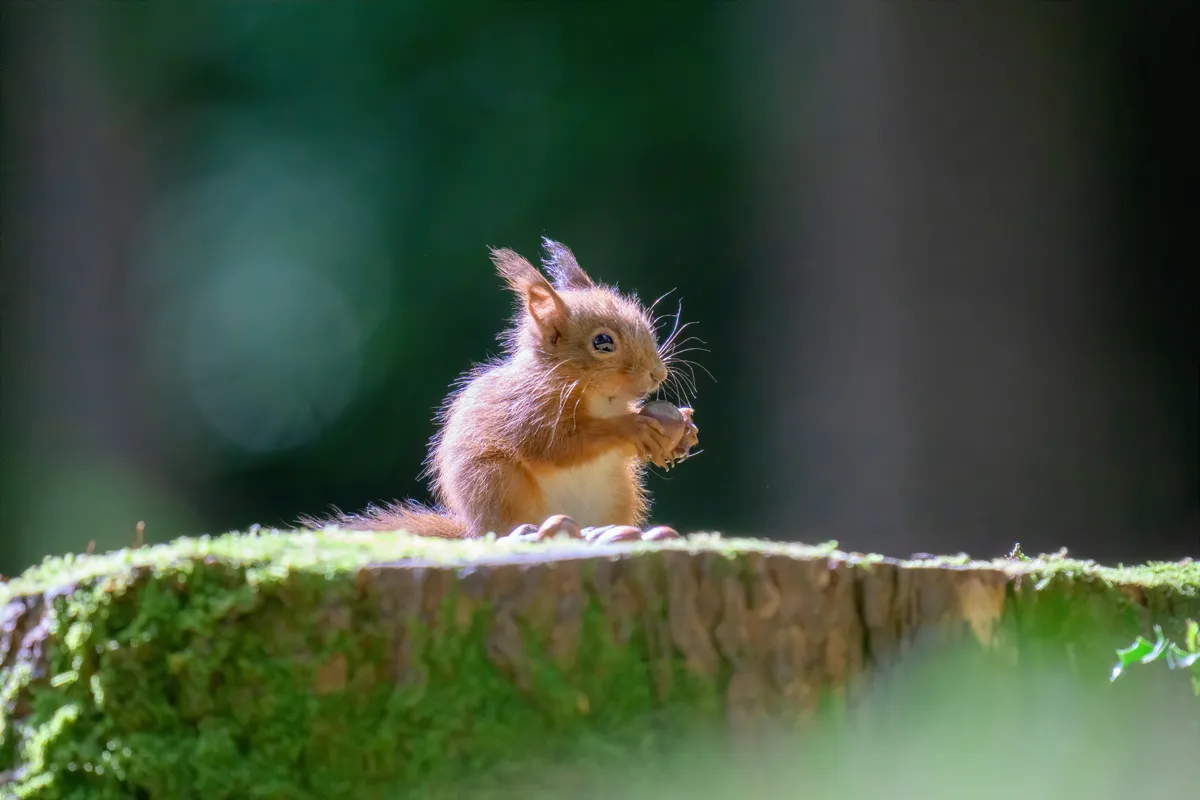
Red squirrel kits begin to leave the nest at around seven weeks old, and will be fully weaned by weeks eight to ten. A newly independent young red squirrel looks like a smaller version of the adult.
Only one in six red squirrels survives past their first birthday. The young squirrel is vulnerable to disease, food-crop failure, competition by grey squirrels for food and living space and attacks from carnivores, crows and birds of prey.
Do red squirrels hibernate?
Neither red squirrels nor grey squirrels hibernate. They do spend more time in their nests (called dreys) in the colder months. By ‘caching’ food during autumn, they are able to spend less time away from the warmth of their dreys foraging for food during winter, minimising energy loss in cold weather.
However, noisy breeding behaviour can be observed from December through to March (when the first kits are born) involving wild chases through the tree-canopy and spiralling round tree-trunks. Moreover, fresh squirrel footprints can be seen daily in snow.
Dreys are spherical nests of approximately 30cm in diameter, with a woven frame of twigs thickly lined with moss and grass. The drey is usually at least six metres off the ground and may be in a hole in a tree or set against the trunk and branches.
Typically each squirrel has five or six dreys at its disposal at any time, and individuals may use each other’s dreys. It is thought that multiple dreys may help to avoid predation in the drey and provide backups in case one gets damaged. They will abandon a drey if it is too full of fleas.
Dreys are notoriously difficult to see clearly enough from the ground to distinguish them from birds’ nests. When seen clearly, a fresh red squirrel drey tends to appear as a neater sphere of freshly-cut twigs and stems, while grey squirrel dreys tend to be larger and are typically made of fully-leafed twigs. However, they may use each other’s dreys.
Are red squirrels endangered?
The red squirrel is classed as an endangered species in Britain, near-threatened in Scotland, and are protected by law.
It is illegal to kill, injure or take a red squirrel, damage or destroy a red squirrel drey or disturb a red squirrel when it is occupying a structure or place for shelter or protection.
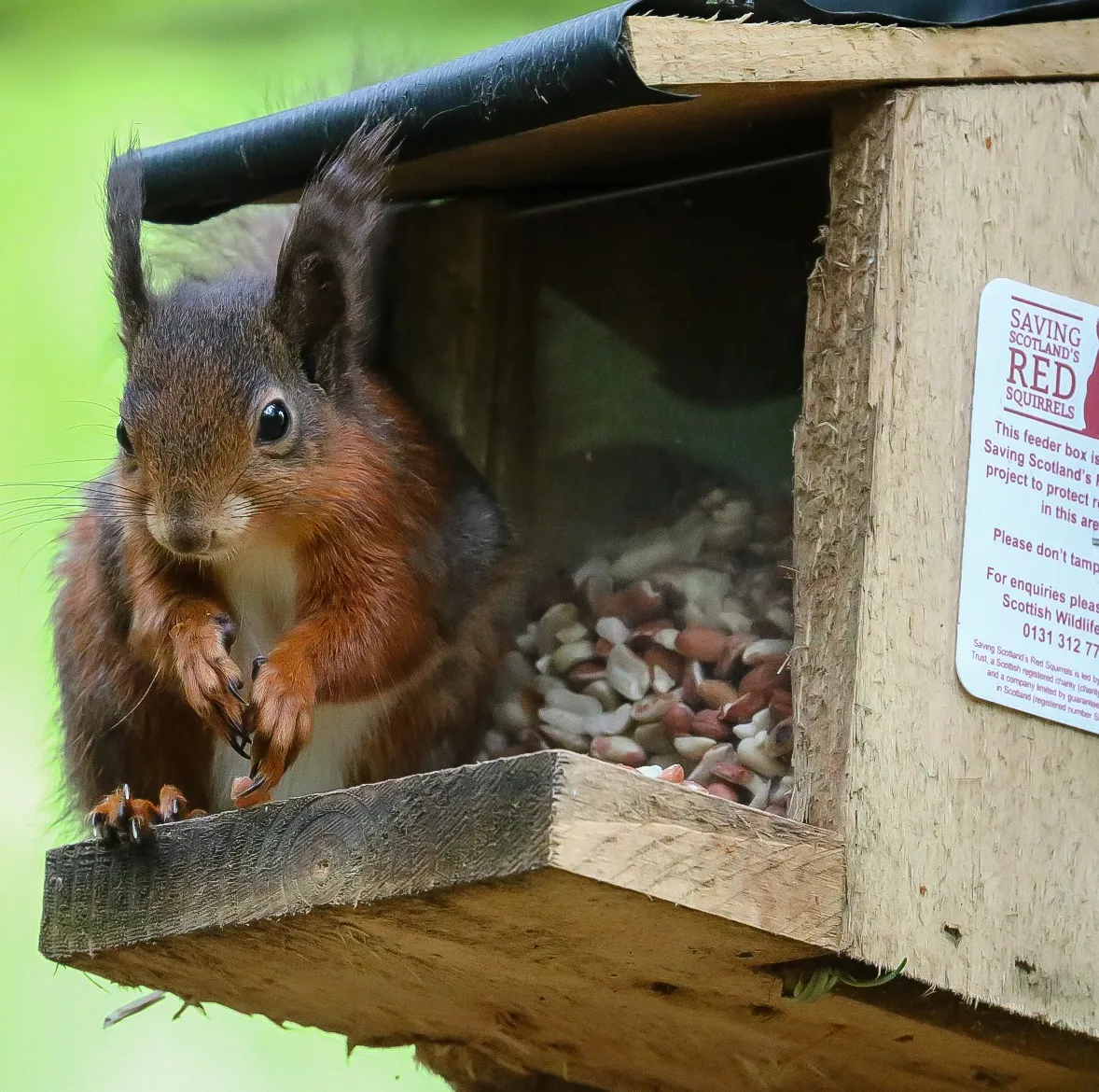
What threats do red squirrels face?
The greatest threat to the red squirrel’s future in Scotland and the United Kingdom is the invasive non-native grey squirrel. Larger and more robust, they not only compete more successfully than the reds for food and resources, they can also carry a deadly disease called squirrelpox.
Squirrelpox virus (SQPV) can be carried by grey squirrels without causing any symptoms, but is typically fatal for red squirrels within two weeks of infection. It produces weeping scabs around the eyes, nose, mouth, ears, feet and genitalia. The infected squirrel is very quickly unable to feed properly, and rapidly becomes unwell.
The destruction of woodland has also contributed to the red squirrel’s decline. Habitat fragmentation, when areas of woodland become separated by development and changing land-use, is also problematic. These isolated areas are often too small to support healthy and sustainable populations of wildlife, including red squirrels. However, in Scotland government agencies are working hard to increase woodland cover by planting both commercial conifers and native woodland.
Red squirrels are only currently under threat in Great Britain, Ireland and parts of Italy where populations have decreased in recent years due to competition from grey squirrels.
What is the scientific name of the red squirrel?
The scientific name of the red squirrel is Sciurus vulgaris. Scientists currently recognise around 16 subspecies of red squirrels.
What is being done to help red squirrels in the UK?
Across the UK, conservationists are working to secure the future of the red squirrel. Without action, the species could become perilously threatened with extinction within a lifetime. To allow remaining red squirrel populations to re-establish and thrive once more, work is being undertaken to protect the native woodland habitat in which red squirrels live and, crucially, to halt or reverse the spread of the invasive non-native grey squirrel, including in several Scottish strongholds which are currently well beyond the reach of grey squirrels.
Saving Scotland’s Red Squirrels, a project led by the Scottish Wildlife Trust in partnership with NatureScot, Scottish Forestry, RSPB Scotland, Scottish Land & Estates and the Red Squirrel Survival Trust is working with local communities to ensure red squirrels will always be a part of Scotland’s special native wildlife.
With the help of partners, landowners and local volunteers, this National Lottery supported project is monitoring squirrel distributions across Scotland, strategically controlling populations of grey squirrel in targeted areas and managing the impact of squirrelpox disease. One of the simplest ways for anyone to contribute to red squirrel protection work in Scotland is to help track distributions of both species by reporting squirrel sightings.
Please note that external videos may contain ads:
The first recorded red squirrel in Plean near Stirling in over 20 years years was spotted in the most unlikely of places! © William Higgins/Saving Scotland's Red Squirrels
Formed in 2018, the Red Squirrel Forum for South Scotland is the umbrella body for (currently) eighteen dedicated volunteer red squirrel protection groups set up across South Scotland by the National Lottery supported Saving Scotland’s Red Squirrels - Developing Community Action project. The Forum is an independent voluntary body which helps to co-ordinate the activities of local communities for the long-term conservation of red squirrel populations in South Scotland. The Forum aims to ensure that volunteer efforts across the Scottish-English border are complementary.
In the Scottish Highlands a Red Squirrel Reintroduction Project led by Trees for Life, aims to reintroduce red squirrels to 10 sites in the northwest Scottish Highlands, adding new populations to the areas of Scotland that are currently free from grey squirrels and the threat of squirrelpox.
Guidance has been published in Scotland to encourage woodland management to benefit particular species, including red squirrels, and for forestry operations to have as little impact as possible. The creation and maintenance of wildlife corridors promotes important connectivity between woodland habitats for species like the red squirrel.
A major contributor to UK red squirrel conservation is the recently completed Red Squirrels United project, which held its final conference in February 2020 after a five-year programme of research and practical conservation in key sites across the UK.
In England, partnership projects such as Red Squirrels Northern England are working to conserve the northern population of red squirrels; RSNE builds on the efforts of previous and current initiatives to protect red squirrels through targeted and strategic action. The project is principally based in Cumbria, Northumberland, Merseyside, Lancashire, north-west Durham, Tyne & Wear and the Yorkshire Dales, in areas where wild red squirrels can still be found.
Northern Red Squirrels is the voluntary umbrella body for voluntary red squirrel conservation groups in northern England. Sightings of both red and grey squirrels in the region can also be reported online.
In Wales the longest acting and most successful red squirrel conservation project to date is the Anglesey Red Squirrel Project, which restored red squirrels to the island of Anglesey through concerted grey squirrel control and red squirrel population reinforcement between 1998 and 2013. Current projects in Wales include the Mid Wales project and the Red Squirrels Trust Wales.
For Northern Ireland, there is a project that works with volunteer groups to protect red squirrels.
UK Squirrel Accord is a UK-wide partnership of 37 leading conservation and forestry organisations, Government agencies and companies, with links to voluntary red squirrel conservation groups. It aims to facilitate the sharing of information between the different squirrel management interests in the UK.
Thanks to these efforts, in many places red squirrels are starting to make a comeback.
Saving Scotland's Red Squirrels is a partnership project working with communities to protect red squirrels in the areas where they are most under threat from the spread of grey squirrels.
Main image: Red squirrels in a woodland near Ambleside, Lake District, UK. © Matt Staniek
